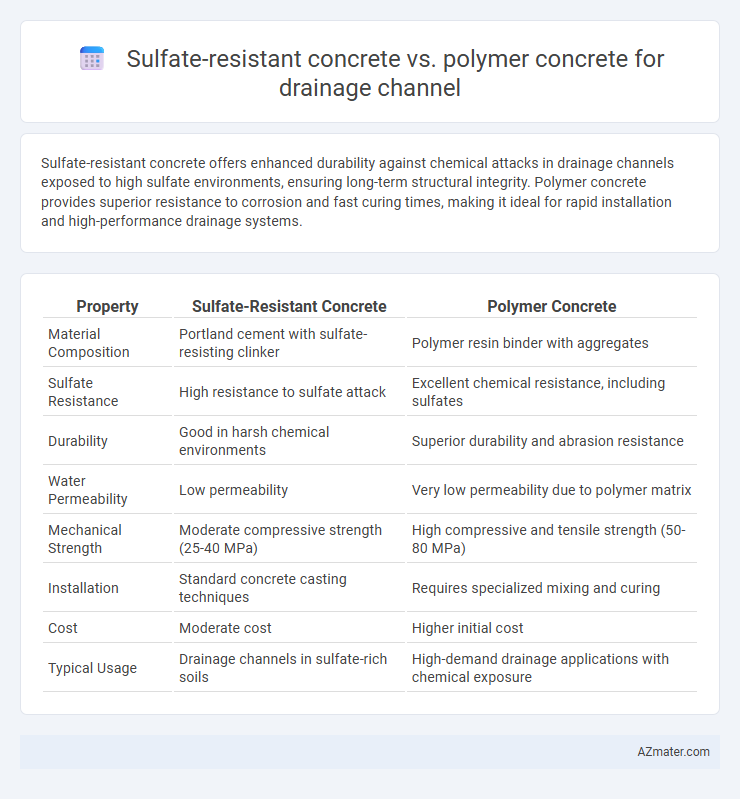Sulfate-resistant concrete offers enhanced durability against chemical attacks in drainage channels exposed to high sulfate environments, ensuring long-term structural integrity. Polymer concrete provides superior resistance to corrosion and fast curing times, making it ideal for rapid installation and high-performance drainage systems.
Table of Comparison
| Property | Sulfate-Resistant Concrete | Polymer Concrete |
|---|---|---|
| Material Composition | Portland cement with sulfate-resisting clinker | Polymer resin binder with aggregates |
| Sulfate Resistance | High resistance to sulfate attack | Excellent chemical resistance, including sulfates |
| Durability | Good in harsh chemical environments | Superior durability and abrasion resistance |
| Water Permeability | Low permeability | Very low permeability due to polymer matrix |
| Mechanical Strength | Moderate compressive strength (25-40 MPa) | High compressive and tensile strength (50-80 MPa) |
| Installation | Standard concrete casting techniques | Requires specialized mixing and curing |
| Cost | Moderate cost | Higher initial cost |
| Typical Usage | Drainage channels in sulfate-rich soils | High-demand drainage applications with chemical exposure |
Introduction to Drainage Channel Materials
Sulfate-resistant concrete is specifically formulated to withstand aggressive sulfate environments commonly found in wastewater drainage channels, offering enhanced durability and extended service life. Polymer concrete, incorporating polymer binders, provides superior chemical resistance, reduced permeability, and faster curing times, making it ideal for highly corrosive drainage applications. Selecting the appropriate material depends on site-specific chemical exposure, mechanical load requirements, and maintenance considerations to ensure optimal performance and longevity of drainage channels.
Understanding Sulfate-Resistant Concrete
Sulfate-resistant concrete is specifically designed to withstand aggressive sulfate environments commonly found in drainage channels by incorporating low C3A cement and supplementary cementitious materials like fly ash or slag, which reduce permeability and enhance durability. This type of concrete effectively resists sulfate attack, preventing deterioration such as expansion, cracking, and spalling, ensuring long-term structural integrity. In contrast, polymer concrete offers chemical resistance and improved bonding but may lack the comprehensive sulfate resistance and cost-effectiveness provided by sulfate-resistant concrete for large-scale drainage infrastructure.
Exploring Polymer Concrete Composition
Polymer concrete for drainage channels contains a resin binder, often vinyl ester or epoxy, combined with aggregates such as quartz or silica sand, providing superior chemical resistance and durability compared to sulfate-resistant concrete, which relies on cementitious materials with additives to combat sulfate attack. The polymer matrix creates a non-porous surface, reducing water absorption and preventing sulfate ion penetration, leading to enhanced lifespan in aggressive environments. Polymer concrete's rapid curing and high mechanical strength also contribute to better performance in drainage applications exposed to harsh chemicals and fluctuating pH levels.
Chemical Resistance: Sulfate-Resistant vs Polymer Concrete
Sulfate-resistant concrete offers superior resistance to sulfate attack caused by soil and groundwater, making it ideal for drainage channels exposed to harsh chemical environments. Polymer concrete, composed of resin binders, provides enhanced chemical resistance against a broader range of aggressive chemicals, including acids and solvents, beyond sulfates. Choosing between these materials depends on the specific chemical exposure, with sulfate-resistant concrete excelling in sulfate-rich conditions and polymer concrete offering versatile protection in chemically diverse drainage systems.
Durability and Longevity in Harsh Environments
Sulfate-resistant concrete offers superior durability in drainage channels exposed to aggressive sulfate-rich soils and waters, significantly reducing deterioration caused by sulfate attacks and ensuring extended structural longevity. Polymer concrete provides enhanced chemical resistance and mechanical strength, making it highly resistant to acidic and corrosive environments while maintaining excellent abrasion resistance. Both materials excel in harsh conditions, with sulfate-resistant concrete favored for sulfate-heavy sites and polymer concrete preferred when exposure to a wide range of chemicals and mechanical stress is expected.
Installation and Workability Differences
Sulfate-resistant concrete offers superior durability in aggressive environments but requires longer curing times and careful moisture control during installation to prevent cracking. Polymer concrete features excellent chemical resistance and rapid curing, enhancing ease of handling and faster project turnaround in drainage channel applications. Workability of polymer concrete is generally higher due to its lightweight nature and better adhesion properties, whereas sulfate-resistant concrete demands skilled placement to ensure homogenous mixing and effective sulfate protection.
Cost Analysis and Economic Considerations
Sulfate-resistant concrete typically incurs lower initial material costs compared to polymer concrete, making it more budget-friendly for large-scale drainage channel projects. Polymer concrete, while more expensive upfront, offers superior chemical resistance and longer service life, potentially reducing maintenance and replacement expenses over time. Economic considerations must weigh immediate budget constraints against long-term durability and lifecycle costs to optimize investment in drainage infrastructure.
Environmental Impact and Sustainability
Sulfate-resistant concrete offers superior durability in aggressive sulfate-rich environments, reducing the frequency of repairs and resource consumption over time, which enhances sustainability in drainage channel construction. Polymer concrete, made using resins and recycled aggregates, exhibits lower permeability and chemical resistance, but its environmental footprint varies depending on the type of polymer used, with some polymers contributing to non-biodegradable waste. Choosing between these materials requires assessing local environmental conditions and sustainability goals, emphasizing lifecycle environmental impacts, recyclability, and resource efficiency.
Maintenance Requirements and Lifespan
Sulfate-resistant concrete offers enhanced durability against chemical attack, reducing maintenance frequency and extending lifespan to approximately 50 years in drainage channels exposed to sulfate-rich environments. Polymer concrete, known for its superior chemical resistance and minimal permeability, requires less maintenance due to its resistance to cracking and corrosion, with an estimated lifespan exceeding 30 years. Both materials significantly outperform standard concrete, but sulfate-resistant concrete is preferred for longer-term installations where exposure to harsh sulfates is predominant.
Conclusion: Choosing the Right Material for Drainage Channels
Sulfate-resistant concrete offers superior durability in environments with high sulfate concentrations, making it ideal for drainage channels exposed to aggressive soils and groundwater. Polymer concrete provides excellent chemical resistance and mechanical strength but may incur higher costs and complex installation. Selecting the right material depends on site-specific factors such as sulfate exposure levels, budget constraints, and required lifespan for drainage infrastructure.

Infographic: Sulfate-resistant concrete vs Polymer concrete for Drainage channel
 azmater.com
azmater.com